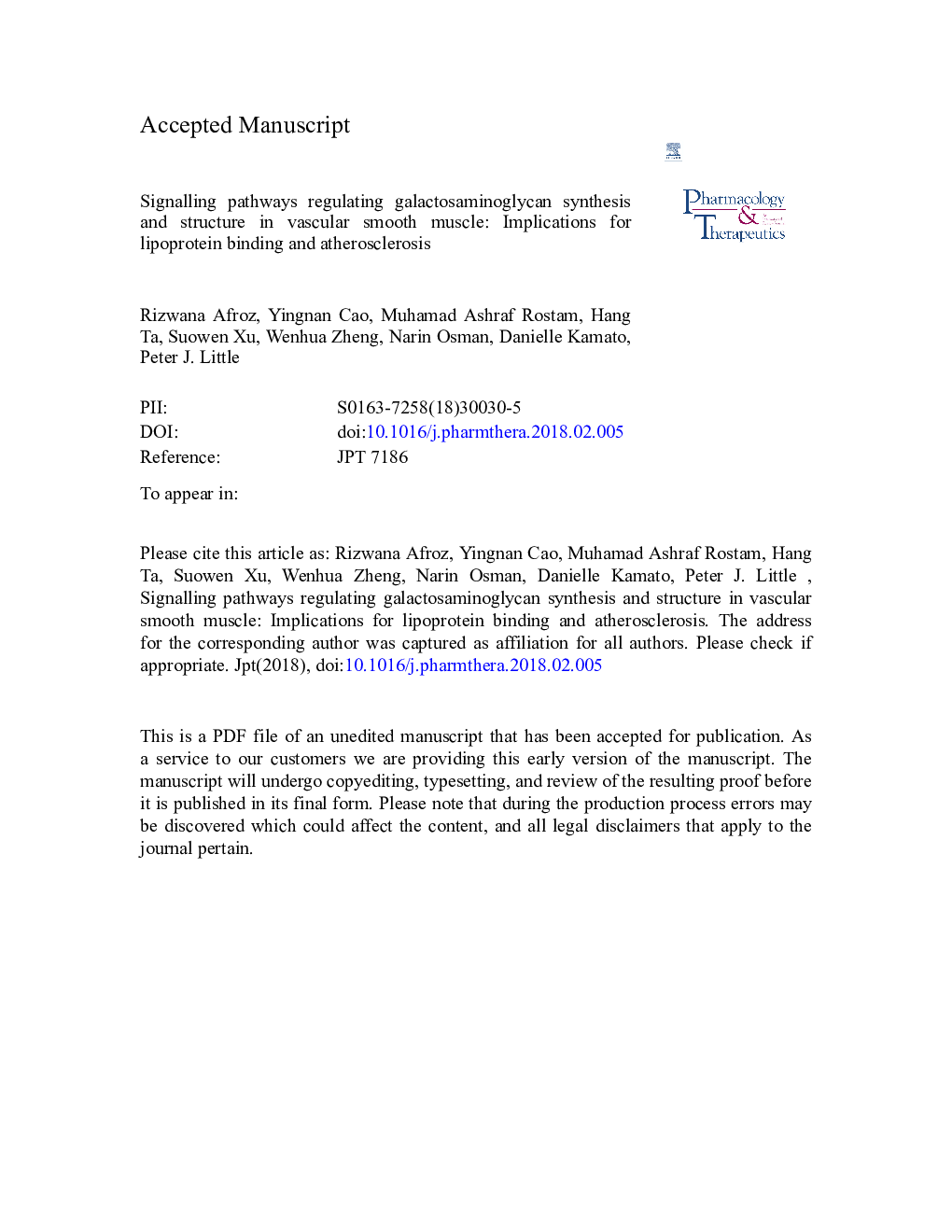| Article ID | Journal | Published Year | Pages | File Type |
|---|---|---|---|---|
| 8536803 | Pharmacology & Therapeutics | 2018 | 47 Pages |
Abstract
Atherosclerosis commences with the trapping of low density lipoproteins (LDLs) in blood vessels by modified proteoglycans (PGs) with hyperelongated glycosaminoglycan (GAG) chains. GAG chain synthesis and growth factor mediated hyperelongation regulates the composition and size of PGs in a manner that would cause low density lipoprotein (LDLs) retention in vessel wall. Galactosaminoglycans are a class of GAGs, commonly observed on PGs. Multiple enzymes are involved in galactosaminoglycan biosynthesis. Galactosaminoglycan synthesis is regulated by various signalling pathways which are amenable to pharmacological manipulation to treat atherosclerosis. Receptor mediated signalling pathways including protein tyrosine kinase receptors (PTKRs), serine/threonine kinase receptors (S/TKRs) and G-protein coupled receptors (GPCRs) pathways regulate galactosaminoglycan synthesizing enzyme expression. Increased expression of these enzymes modify galactosaminoglycan chain structure by making them hyperelongated. This review focuses on the signalling pathways regulating the expression of genes involved in galactosaminoglycan synthesis and modification. Furthermore, there are multiple other processes for inhibiting the interactions between LDL and galactosaminoglycans such as peptide mimetics of ApoB100 and anti-galactosaminoglycan antibodies and the therapeutic potential of these strategies is also addressed.
Keywords
GalNAcLDLsIdoA3-hydroxy-3-methyl-glutaryl-coenzyme AIP3HMGCoAGPCRET-1GlcAPLCVSMCsPKCGALTDSESOSPDGFChPFPCSK9PDGFRPGSTHRproteoglycansGAGsC6SEGFRGlcATPI3KEGFGalNAcTChSymAbMmpsinositol 1,4,5 triphosphateXylC4STGFBRGlcNAcTGF-βChondroitin synthaseXylosyltransferaseUSTN-acetyl-d-glucosamineCDKsCVDsERK1/2G-protein coupled receptorsN-Acetyl-D-GalactosamineAtherosclerosisMonoclonal antibodyangiotensin-IIiduronic acidGlucuronic acidendothelin-1SERCardiovascular diseasestransforming growth factor-βtransforming growth factor-β receptorthreonineTyrTyrosineAng-IISerineVascular smooth muscle cellsDermatan sulfateepidermal growth factorchondroitin polymerizing factorplatelet derived growth factorphospholipase Cphosphoinositide 3-kinaselow density lipoproteinsMatrix metalloproteinasesSignalling pathwaysProtein kinase CProprotein convertase subtilisin/kexin type 9son of sevenlessplatelet derived growth factor receptorchondroitin-4-sulfateChondroitin-6-sulfateChondroitin sulfateextracellular signal-regulated kinase 1/2cyclin-dependent kinasesGalGalactoseXyloseGlycosaminoglycansEpidermal growth factor receptor
Related Topics
Health Sciences
Pharmacology, Toxicology and Pharmaceutical Science
Pharmacology
Authors
Rizwana Afroz, Yingnan Cao, Muhamad Ashraf Rostam, Hang Ta, Suowen Xu, Wenhua Zheng, Narin Osman, Danielle Kamato, Peter J. Little,
